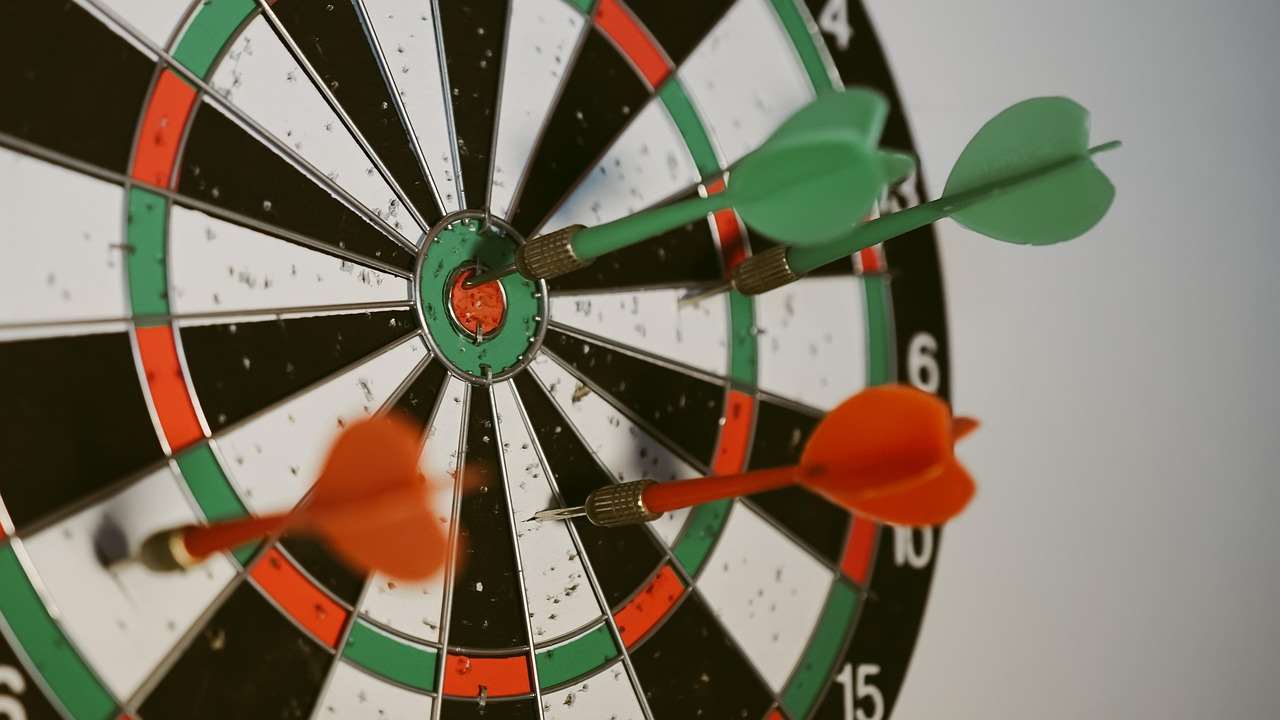Darts cricket scoring is a unique and engaging way to play darts, focusing on strategically closing out numbers rather than simply racking up points. This article will provide a comprehensive guide to understanding, playing, and mastering this exciting variation of darts, covering everything from the basic rules to advanced strategies.
⚠️ Still Using Pen & Paper (or a Chalkboard)?! ⚠️
Step into the future! The Dart Counter App handles all the scoring, suggests checkouts, and tracks your stats automatically. It's easier than you think!
Try the Smart Dart Counter App FREE!Ready for an upgrade? Click above!
Understanding Darts Cricket Scoring: The Basics
At its core, darts cricket scoring revolves around “closing” specific numbers on the dartboard before your opponent. These numbers are typically 20, 19, 18, 17, 16, 15, and the bullseye (both the outer bull and the inner bull). The first player to close all these numbers and have a higher or equal score wins the game.
The Numbers in Play
- 20: The highest single number, making it a frequent target.
- 19: Another high-scoring number, often targeted early in the game.
- 18: A strategic number, close to the triple 20.
- 17: Less common but still important for closing.
- 16: A number easily divisible for strategic outs.
- 15: Similar to 16, provides opportunities for doubles and trebles.
- Bullseye: Counts as two separate hits – the outer bull (25 points, counts as one mark) and the inner bull (50 points, counts as two marks).

Opening and Closing Numbers
To “open” a number, you need to hit it three times. This can be achieved through any combination of singles, doubles, or trebles. For example, three single 20s, a single 20 and a double 20, or a triple 20 all count as opening the 20. Once a number is open, you can score points on it if your opponent hasn’t closed it yet. If your opponent closes the number first, you can no longer score on that number, even if you opened it already. It’s crucial to be aware of which numbers you need to open and which ones your opponent hasn’t closed yet.
The Rules of Engagement: How to Play Darts Cricket
Playing darts cricket scoring involves a strategic blend of offense and defense. The game starts with a coin toss to determine who goes first. The first player then throws three darts at the board. The goal is to either open numbers or score points on numbers that are already open but not yet closed by your opponent.
Scoring Points
Once you’ve opened a number, any subsequent hits on that number will earn you points, provided your opponent hasn’t closed it. These points are added to your running total. For instance, if you’ve opened the 20 and hit a single 20, you score 20 points. A double 20 would score 40, and a triple 20 would score 60. A crucial element of the game is to keep a online darts scorer handy to track points and closed numbers.
Closing Numbers
Closing a number means hitting it three times after it has been opened by either you or your opponent. Once a number is closed, no player can score on it anymore. If both players have opened the number, the first to close it prevents further scoring on that number. This introduces a significant defensive element to the game. The strategy of closing numbers early or focusing on scoring depends heavily on your opponent’s skill level and playing style.

Winning the Game
The winner of darts cricket scoring is the first player to:
- Close all seven numbers (20, 19, 18, 17, 16, 15, and the bullseye).
- Have a score that is equal to or greater than their opponent’s score.
This “equal or higher” score requirement adds another layer of strategy. You can’t simply close all the numbers and win; you must also ensure you have enough points to be ahead or tied. This often leads to tense finishes where players are strategically targeting specific numbers to either score points or prevent their opponent from doing so.
Strategies for Success in Darts Cricket Scoring
Mastering darts cricket scoring requires more than just accurate throwing; it demands a strategic approach. Understanding when to attack, defend, and prioritize certain numbers is key to victory. Here are some strategies to elevate your game:
Prioritize Opening High Numbers
Focus on opening the 20 and 19 early in the game. These are the highest-scoring numbers, and opening them quickly allows you to accumulate points rapidly if your opponent doesn’t close them. However, be mindful of your opponent’s strategy. If they are consistently hitting the 20, it might be wise to switch to a different number to throw them off. Knowing how to play darts method can definitely assist with making such decision.
Defensive Closing
If your opponent is consistently scoring on a particular number, prioritize closing it, even if you haven’t opened it yourself. This can shut down their scoring opportunities and force them to focus on opening other numbers. Don’t be afraid to sacrifice a few points to prevent your opponent from racking up a massive lead. The ability to quickly buy a dart board for practice allows for refinement of these defensive strategies.
Targeting Weaknesses
Pay attention to your opponent’s weaknesses. If they struggle with a particular number, focus on opening and scoring on it. This puts pressure on them to improve that number or risk falling behind. Observing your opponent closely and adapting your strategy accordingly is crucial.
The Importance of the Bullseye
The bullseye can be a game-changer in darts cricket scoring. It’s worth two marks (25 for the outer, 50 for the inner), making it a fast way to close that number. However, it’s also a smaller target, so accuracy is paramount. Practicing your bullseye throws is essential, especially towards the end of the game.
Strategic Scoring
Don’t always aim for the highest score. Sometimes, a single hit on an open number is enough to put you ahead or maintain your lead. Consider the overall score and your opponent’s position before each throw. Strategic scoring involves making calculated decisions to maximize your chances of winning.
Mental Game
Cricket can be a mental battle. Staying calm and focused under pressure is vital. Don’t let a few bad throws derail your game. Maintain a positive attitude and focus on your strategy. The mental aspect of darts is just as important as the physical skill.

Advanced Techniques and Tactics
Beyond the basic strategies, there are several advanced techniques and tactics that can give you an edge in darts cricket scoring. These require practice and a deep understanding of the game’s dynamics.
Setting Up Outs
Similar to standard darts, setting up outs in cricket involves strategically positioning yourself to close a number with your last dart. This might involve leaving yourself a double or a triple on a number you need to close. Careful planning and calculation are essential for setting up successful outs.
Controlling the Pace
You can control the pace of the game by strategically opening or closing numbers. If you’re ahead, you might focus on closing numbers to prevent your opponent from scoring. If you’re behind, you might prioritize opening high-scoring numbers to catch up quickly. Understanding how to manipulate the pace can give you a significant advantage.
Reading Your Opponent
Pay close attention to your opponent’s body language and throwing habits. Are they showing signs of frustration? Are they consistently missing a particular target? Use this information to your advantage by adjusting your strategy and applying pressure where they are weakest. Also, it is always helpful to dart store near me to analyze your opponents gear.
The Importance of Practice
Like any skill, mastering darts cricket scoring requires consistent practice. Focus on improving your accuracy, consistency, and strategic thinking. Regular practice will help you develop muscle memory and improve your ability to perform under pressure. Consider using a Dart game scoring app to track your progress.

Variations of Darts Cricket Scoring
While the standard version of darts cricket scoring is the most common, there are several variations that add different twists to the game. These variations can be a fun way to challenge yourself and your opponents.
Cut-Throat Cricket
In Cut-Throat Cricket, the scoring is reversed. Instead of scoring points for yourself when you hit an open number, you add points to your opponent’s score. The goal is to close all the numbers and have the lowest score. This variation adds a significant defensive element to the game, as you’re constantly trying to avoid scoring points for your opponent. It also forces the ability to how long darts oche
Cricket Count-Up
This variation combines elements of both standard cricket and count-up darts. Players still need to close the numbers, but they also accumulate points as they do so. The winner is the first player to close all the numbers and reach a predetermined score. This version adds a greater emphasis on scoring quickly and efficiently.
Conclusion: Mastering the Art of Darts Cricket Scoring
Darts cricket scoring is more than just a game; it’s a strategic battle of wits and skill. By understanding the rules, mastering the basic techniques, and developing advanced strategies, you can elevate your game and become a formidable opponent. Remember to prioritize opening high numbers, defend strategically, and practice consistently. So grab your darts, gather your friends, and start playing! Are you ready to take your darts game to the next level? Consider exploring different dart types and equipment to optimize your performance and style. Find out what darts does luke littler play with!

Hi, I’m Dieter, and I created Dartcounter (Dartcounterapp.com). My motivation wasn’t being a darts expert – quite the opposite! When I first started playing, I loved the game but found keeping accurate scores and tracking stats difficult and distracting.
I figured I couldn’t be the only one struggling with this. So, I decided to build a solution: an easy-to-use application that everyone, no matter their experience level, could use to manage scoring effortlessly.
My goal for Dartcounter was simple: let the app handle the numbers – the scoring, the averages, the stats, even checkout suggestions – so players could focus purely on their throw and enjoying the game. It began as a way to solve my own beginner’s problem, and I’m thrilled it has grown into a helpful tool for the wider darts community.